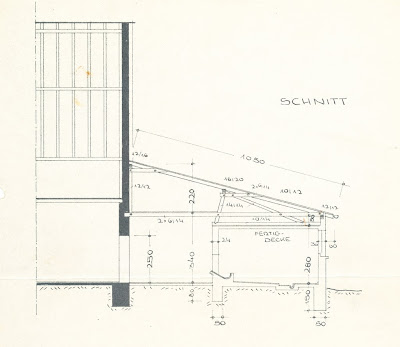 |
| Location of the barn. |
The barn is a massive structure, with a 360 sq.m. footprint (c. 23x16m), and around 12m high at the highest point, giving it a rather large volume. As
described earlier, it has undergone considerable extension, starting with a relatively small rectangular footprint, with stone construction for the lower 3m, and the remaining as half-timbered, much as it is today.
This modest barn was extending into an irregular polygon (see the red elements in the plans below) around 1922 when the main hall was extended, incorporating a ground floor cellar. The odd-shaped footprint seemed to be on account of the plot of land being irregular, and the little corner that would have made it square falling on a neighbour's plot of land.
 |
| Extension floor plan, August 1922. |
 |
| Extension elevation and sections, August 1922. |
By 1947, this was resolved, and the building was squared with another extension, enlarging the cellar at the same time. The plans we have from this time illustrate what it must have looked like back then rather well (see the elevations at the bottom of the image below), and show a much more complex roof surface than exists today.
 |
| Extension proposal, May 1947. |
At this point in time, the southern side of the barn (or the left side, when looking at the
Hintere Ansicht (Ost), at the lower left of the image above) was adjoined by a neighbours barn, unfortunately not shown in these plans. By 1960, this adjoining barn was razed, and a "modern" extension built onto the southern side housing stalls and a "feeding hall".
 |
| Extension proposal, April 1960 |
At some point in time, the roof on the main barn was simplified into the two surfaces it currently has, but we have no records of when that was done, but presumably between 1947 and 1960.
 |
| The barn viewed from the east, January 2011. |
 |
| Lots of ladders in the main hall. |
The main building currently comprises of a central hall, to the north of which are two “cellars” (one was not marked on the above old plans), which are partially underground owing to the barn being built into a slope. Above this is a large, open volume, currently home to bails of straw, spread across several “floors”, for want of a better word. Some of these floors are made of planks, some are simply round timbers laid between the large beams, allowing air to circulate below the straw, which essentially provides a surface to walk on. One level is like a room within the barn, with a door at one side, but open on the other, the reason for which is a complete mystery to me, but may represent an upper-level door in the former external wall of the original barn. Several ladders, firmly attached to the structural beams, provide access to these upper levels, and are not a climb for those suffering from even the slightest touch of vertigo.
 |
| The stalls in the 1960s extension |
The extension on the southern side is simple, being divided into two halves, one with a large door for access, and the other with a smaller door. The former might be described as a feed hall, with hatches providing access to the feeding troughs in the stalls housed in the southern half.
 |
| Former line of gable at southern end clearly visible, January 2011. |
We have no concrete plans for the barn at this stage. The structure appears sound, though some spot repairs to edges of the roof and the gutters is required. We’d like to replace the asbestos sheeting roof of the extension with something else, but even that will have to wait a couple of years, as it is not currently a risk, as they are not decaying. The cellars could do with some freshening up, and the exposed steel beams of their ceilings treated with a rust preventer, and we’ll dispose of the straw, most likely giving it to someone in the locality whose barn burnt down, and who needs bedding for his horses. The stalls would make a great workshop, as it's bright and airy there, so that might be where some of the old furniture will get restored.
However, the biggest short-term job that needs to be done is satisfying the requirements of fire protection, and new rules that came in a couple of years ago. As the house is almost touching the barn, certain measures (we're not sure what yet) have to be taken, but at least the timbers are over a certain dimension threshold, and it appears the filling between the timbers is brick and plaster, and not wattle and daub, which helps. Fire retardant materials or windows may need to be used on the eastern gable of the house to satisfy the rules, which we believe are the remaining outstanding issue for our planning application.
 |
| The barns from the front, January 2011. |
Of course the brewer in me has all sorts of dreams for the barn, but that’s another story.
I'll post more photos of the interior once the weather brightens up.

























